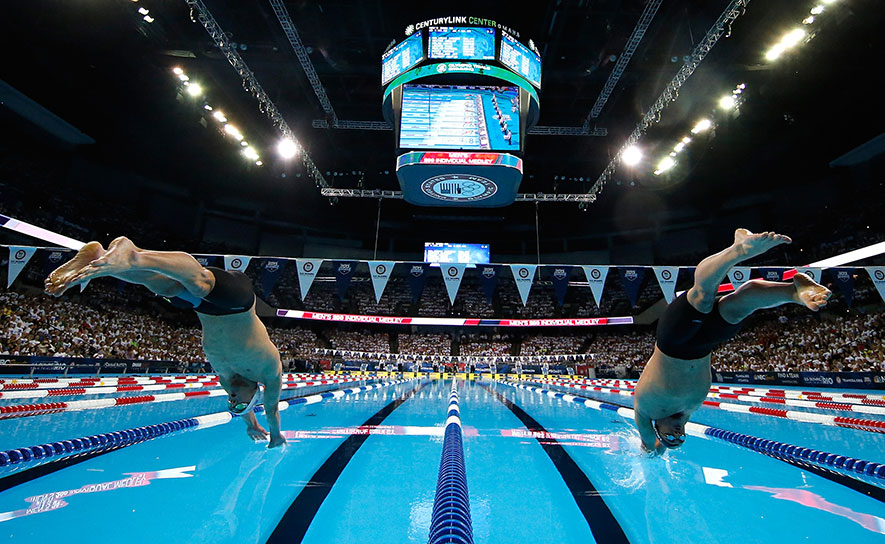USA Swimming News
Behind the 2020 Olympic Trials Cuts: Business, Performance and Analytics

by Tom Slear//Contributor
When looking over the newly released Olympic Trials standards for 2020, you should keep three words in mind: business, performance, and analytics.
Business: There was a time, according to oral history, when the Olympic Trials were just what the title implies – a meet to determine the U.S. Olympic team. Those who showed up to compete sincerely thought they had a chance to make the team. The total number of swimmers was small. Heats per event were few.
Written history tells a much different story. Fifty-nine swimmers and nine heats were in the 100 free at the 1956 Trials at the Brennan Pools in Detroit. In 2016 at the CenturyLink Center (now the CHI Health Center) in Omaha, there were 88 swimmers and 10 heats. In the preliminaries in 1956, 21 swimmers finished with a time that was more than four seconds slower than what it would take to make the team. In 2016, only one swimmer was that far off the mark.
The real difference between the two trials was the venues. Brennan Pools, an outdoor facility, could handle roughly 3,000 spectators. Nothing much changed with the venues in the ensuing 50 years. The CenturyLink Center, an indoor showplace adapted for a swimming meet, seated 14,500. Tickets for preliminaries and finals were sold out weeks in advance.
The radical makeover grew out of a decision by USA Swimming after the 2000 Olympic Trials in Indianapolis. The organization held its 2004 Olympic Trials in a temporary location in Long Beach, Calif., a venue that held over 10,000 spectators, nearly tripling the capacity of the IU Natatorium in Indianapolis.
Then at the 2004 Games in Athens, Michael Phelps became a star who transcended the sport’s traditional limits. He had the drawing power to transform the Trials from a meet to an event. Why not pack a large venue with swimmers and spectators?
The outcome was better than anyone hoped for. USA Swimming settled on the CenturyLink Center (then called Qwest Center) for the 2008 Trials and every Trials since. For two weeks, two temporary pools replaced the basketball court. With the standards mostly unchanged from 2004 and a boost from the technical suits, over 1,200 swimmers qualified. They competed in front of mostly standing-room-only crowds.
By 2016, just over 1,700 swimmers qualified. Some 220,000 tickets were sold for the eight days of the competition. USA Swimming had captured lightening in a bottle.
Yet many worried that the business of the trials had usurped its main purpose, which was to provide the most favorable conditions possible for America’s elite swimmers to go head-to-head for a spot on the Olympic team.
Performance: One question that needed to be addressed was how to balance the competitive side with the commercial side.
Only 150 or so swimmers in any Olympic year have a realistic chance of making the team. Such a small meet would stifle attendance of not only of spectators, but also the up-and-coming swimmers who would use a Trials experience in their quest to make an Olympic team in four or eight years.
USA Swimming wrestled with the sweet spot between business and performance and ultimately settled on 1,400 swimmers for the 2020 Olympic Trials.
Analytics: USA Swimming’s times database, SWIMS, went live in 2003. What was first an attempt to capture all times from all meets and make them easily accessible online to the public has evolved into a comprehensive data base that’s now ripe for analytics, or more precisely, machine learning, in coming up with time standards.
“Learning from the data better than a human can” is how Patrick Murphy, USA Swimming’s data research manager describes machine learning. With the right prompts, a database can predict accurately. Murphy, who swam at Notre Dame and has a masters from Georgia Tech in data science, set about using the history contained in SWIMS to predict what adjustments would lead to 1,400 swimmers at the Trials in Omaha in 2020.
The first part was easy. The data indicated the number of swimmers would decrease by 170 simply by shortening the qualifying period from two years to 18 months.
“The college swimmers who make a cut one summer, don’t swim for two years, and then show up at Trials,” Murphy explains.
The remaining 130 or so would have to come out by tweaking the standards.
“We started with the 70th fastest time in each event as our baseline,” Murphy says. “We went into the database for 2010 and 2014 and determined how many would have qualified for the Trials two years later using those times. Using the 70th fastest time in each event in 2018, we could then project how swimmers would qualify for the 2020 Trials.”
That number came to 1,148, 252 swimmers below the target. A handful of coaches took a look and suggested where to make adjustments. That raised the projection to 1,219. A small amount of secret sauce based on intuition was applied to the standards and the projection increased to 1,302.
USA Swimming is aiming for a target between 1,200 and 1,400 athletes.
Swimmers have an uncanny way of rising to the challenge. As Murphy says, “The power of the mind is pretty strong.”
